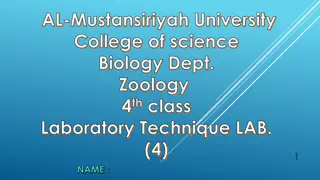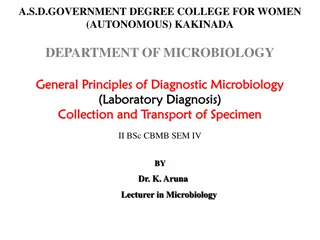Fossorial Specimens: Mole and Caecilian Adaptations
Fossorial specimens, including the mole and caecilian, are uniquely adapted for subterranean burrowing. The mole, commonly known for its wedge-shaped head and reduced eyes, lives in tunnels and feeds on small worms and insects. On the other hand, the limbless caecilian, resembling a worm, thrives in a burrowing life with a smooth, slimy body covered in calcified scales. Both species exhibit fascinating adaptations for life underground, with specific features suited for their habitat and feeding habits.
Download Presentation

Please find below an Image/Link to download the presentation.
The content on the website is provided AS IS for your information and personal use only. It may not be sold, licensed, or shared on other websites without obtaining consent from the author.If you encounter any issues during the download, it is possible that the publisher has removed the file from their server.
You are allowed to download the files provided on this website for personal or commercial use, subject to the condition that they are used lawfully. All files are the property of their respective owners.
The content on the website is provided AS IS for your information and personal use only. It may not be sold, licensed, or shared on other websites without obtaining consent from the author.
E N D
Presentation Transcript
Talpa Kingdom: Animalia Phylum: Chordata Class: Mammalia Order: Eulipotyphl a Family: Talpidae Tribe: Talpini Genus: Talpa
Habit and habitat: It is adapted for subterranean burrowing and lives in tunnels. It feeds on small worms, insects and sprouted seeds. It runs deeper into tunnels.
Commonly called as mole. Head wedge-shaped. Snout elongated having prenasal bone. Snout contains bristles or vibrisae at the tip. Eyes are very much reduced and covered with skin. External ears (pinnae) absent.
Tail is short, sensory and without hair. Tail and feet are fleshy white. Hind limb large and broad containing 5 digits, each having broad nail, used for digging. Forelimb usually with 5 clawed-toes; inner toes not opposable.
Ichthyophis Kingdom: Animalia Phylum: Chordata Class: Amphibia Order: Gymnophiona Clade: Apoda Family: Ichthyophiidae Genus: Ichthyophis
Habit and habitat : Ichthyophis lives in burrows and leads a fussorial life in moist ground. The animal is blind and adapted for burrowing life. It feeds on invertebrates.
The animal is limbless, contains calcified scales and vestigial tail. Commonly called as caecilian. Animal is worm-like and slender, measuring about 30 cm in length. Body divided into head, trunk and tail. Body is covered with a smooth, slimy and transversely ringed skin consisting of small calcified scales arranged in transverse rows.
Squirt glands in skin discharge an irritating fluid. Head contains eyes, nostrils and a pair of sensory tentacles. Tympanic membrane, tympanic cavity and columella absent. Eyes small, functionless and covered by skin. Though reduced but contain all the parts. A small protrusible tentacle is present between eye and nostril. Skull compact, roofed with bone. Limbs and limb girdles absent. Vertebrae amphicoelous.
Teredo Kingdom: Animalia Phylum: Mollusca Class: Bivalvia Subclass: Heterodonta Order: Myida Superfamily: Pholadoidea Family: Teredinidae Genus: Teredo
Teredo navalis, the naval shipworm, is a species of saltwater clam, a marine bivalve mollusc in the family Teredinidae, the shipworms. This species is the type species of the genus Teredo.
Like other species in this family, this bivalve is called a shipworm, because it resembles a worm in general appearance, while at the anterior end it has a small shell with two valves which is adept at boring through wood. It tunnels into underwater piers and pilings and is a major cause of damage and destruction to submarine timber structures and the hulls of wooden boats.
Teredo navalis has an elongated, reddish, wormlike body which is completely enclosed in a tunnel it has made in floating or submerged timber. At the front end of the animal are two triangular, calcareous plates
These are up to 2 cm (34in) long and correspond to the valves of other bivalve molluscs. They are white, with a covering of pale brown periostracum, and have rough ridges. The mollusc uses them to grasp the wood and slowly enlarges the burrow in which it lives. It has retractable inhalant and exhalant siphons which project through a small hole in the horny septum which blocks the opening of the burrow. When the animal is threatened, the siphons can be drawn inside the burrow and protected by a pair of calcareous oar-like pallets. The tunnel is circular in cross section and is lined with calcareous material extruded by the mollusc. It can be up to 60 cm (24 in) long and 1 cm (1 2in) in diameter.
Lepus Kingdom: Animalia Phylum: Chordata Class: Mammalia Order: Lagomorph a Leporidae Family: Genus: Lepus
Habit and habitat: Inhabiting fields, grasslands and woodlands. Gregarious, crepuscular (coming out of burrows for feeding in twilight, coprophagous (eating again their soft stool for maximum nourishment). Polygamous, nocturnal, solitary, nomadic and living in temporary shelters.
Forelimbs and hind limbs more or less equal. Tail short and bushy. Commonly called as Hare. Runs at a speed of 60 kIn per hour. Head contains eyes, tactile whiskers, nares, and longer erect external ears, snout, external nares and mouth. Ears contain external auditory meatus.
Chaetopterus Scientific classification Kingdom: Animalia Phylum: Annelida Class: Polychaeta Order: Canalipalpata Family: Chaetopteridae Genus: Chaetopterus
Chaetopterus or the parchment worm or parchment tube worm is a genus of marine polychaete worm that lives in a tube it constructs in sediments or attaches to a rocky or coral reef substrate. The common name arises from the parchment-like appearance of the tubes that house these worms. Parchment tube worms are filter feeders and spend their adult lives in their tubes, unless the tube is damaged or destroyed. They are planktonic in their juvenile forms, as is typical for polychaete annelids.
The worms are unique among the polychaete worms in the highly derived parapodia of the mid-segments of its body that are used in its specialized filter feeding regime. The worm's parapodia are modified into the shape of fans and used to create suction and pump water through the worm's parchment living tube.
The morphology of the structures are used in identifying species. The worm feeds by using modified structures on its midbody segments that create mucus nets to trap food passed through the net. A flow of water containing plankton and organic debris is created by "circular flaps" on three segments that create suction that draws water through the living tube.
Naja Kingdom: Animalia Phylum: Chordata Class: Reptilia Order: Squamata Suborder: Serpentes Family: Elapidae Genus: Naja
Habit and habitat: Cobra is diurnal, shy, living in holes, under stones, mud walls and in thick vegetation. It is oviparous, carnivorous and feeds on frogs, rats, lizards and other snakes. It hibernates. Three varieties of cobras are found in India : (i) Binocellate form having spectacle-like mark connected by U, found in Maharashtra, (ii) Monocellate with single oval mark surrounded by ellipses found in Bengal, (iii) Non-cellate without mark found in Rajasthan, Gujarat and Madhya Pradesh.
Commonly known as cobra. Naja naja is Indian cobra or Nag. Body divided into head, neck, trunk and tail. Head contains mouth, eyes and nostrils. Neck region is dilatable with elongated ribs. It expands to form hood which contains binocellate mark on dorsal surface. Some persons call it figure of ten. There is a white band around mark























